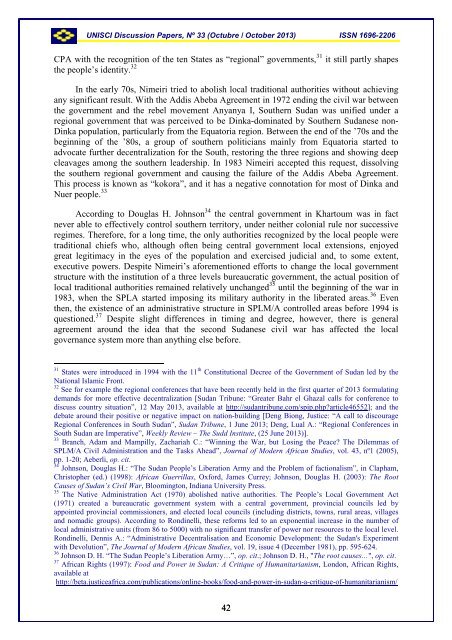UNISCI - Universidad Complutense de Madrid
UNISCI - Universidad Complutense de Madrid
UNISCI - Universidad Complutense de Madrid
Create successful ePaper yourself
Turn your PDF publications into a flip-book with our unique Google optimized e-Paper software.
<strong>UNISCI</strong> Discussion Papers, Nº 33 (Octubre / October 2013) ISSN 1696-2206CPA with the recognition of the ten States as “regional” governments, 31 it still partly shapesthe people’s i<strong>de</strong>ntity. 32In the early 70s, Nimeiri tried to abolish local traditional authorities without achievingany significant result. With the Addis Abeba Agreement in 1972 ending the civil war betweenthe government and the rebel movement Anyanya I, Southern Sudan was unified un<strong>de</strong>r aregional government that was perceived to be Dinka-dominated by Southern Sudanese non-Dinka population, particularly from the Equatoria region. Between the end of the ’70s and thebeginning of the ’80s, a group of southern politicians mainly from Equatoria started toadvocate further <strong>de</strong>centralization for the South, restoring the three regions and showing <strong>de</strong>epcleavages among the southern lea<strong>de</strong>rship. In 1983 Nimeiri accepted this request, dissolvingthe southern regional government and causing the failure of the Addis Abeba Agreement.This process is known as “kokora”, and it has a negative connotation for most of Dinka andNuer people. 33According to Douglas H. Johnson 34 the central government in Khartoum was in factnever able to effectively control southern territory, un<strong>de</strong>r neither colonial rule nor successiveregimes. Therefore, for a long time, the only authorities recognized by the local people weretraditional chiefs who, although often being central government local extensions, enjoyedgreat legitimacy in the eyes of the population and exercised judicial and, to some extent,executive powers. Despite Nimeiri’s aforementioned efforts to change the local governmentstructure with the institution of a three levels bureaucratic government, the actual position oflocal traditional authorities remained relatively unchanged 35 until the beginning of the war in1983, when the SPLA started imposing its military authority in the liberated areas. 36 Eventhen, the existence of an administrative structure in SPLM/A controlled areas before 1994 isquestioned. 37 Despite slight differences in timing and <strong>de</strong>gree, however, there is generalagreement around the i<strong>de</strong>a that the second Sudanese civil war has affected the localgovernance system more than anything else before.31 States were introduced in 1994 with the 11 th Constitutional Decree of the Government of Sudan led by theNational Islamic Front.32 See for example the regional conferences that have been recently held in the first quarter of 2013 formulating<strong>de</strong>mands for more effective <strong>de</strong>centralization [Sudan Tribune: “Greater Bahr el Ghazal calls for conference todiscuss country situation”, 12 May 2013, available at http://sudantribune.com/spip.php?article46552]; and the<strong>de</strong>bate around their positive or negative impact on nation-building [Deng Biong, Justice: “A call to discourageRegional Conferences in South Sudan”, Sudan Tribune, 1 June 2013; Deng, Lual A.: “Regional Conferences inSouth Sudan are Imperative”, Weekly Review – The Sudd Institute, (25 June 2013)].33 Branch, Adam and Mampilly, Zachariah C.: “Winning the War, but Losing the Peace? The Dilemmas ofSPLM/A Civil Administration and the Tasks Ahead”, Journal of Mo<strong>de</strong>rn African Studies, vol. 43, nº1 (2005),pp. 1-20; Aeberli, op. cit.34 Johnson, Douglas H.: “The Sudan People’s Liberation Army and the Problem of factionalism”, in Clapham,Christopher (ed.) (1998): African Guerrillas, Oxford, James Currey; Johnson, Douglas H. (2003): The RootCauses of Sudan’s Civil War, Bloomington, Indiana University Press.35 The Native Administration Act (1970) abolished native authorities. The People’s Local Government Act(1971) created a bureaucratic government system with a central government, provincial councils led byappointed provincial commissioners, and elected local councils (including districts, towns, rural areas, villagesand nomadic groups). According to Rondinelli, these reforms led to an exponential increase in the number oflocal administrative units (from 86 to 5000) with no significant transfer of power nor resources to the local level.Rondinelli, Dennis A.: “Administrative Decentralisation and Economic Development: the Sudan's Experimentwith Devolution”, The Journal of Mo<strong>de</strong>rn African Studies, vol. 19, issue 4 (December 1981), pp. 595-624.36 Johnson D. H. “The Sudan People’s Liberation Army…”, op. cit.; Johnson D. H., "The root causes…", op. cit.37 African Rights (1997): Food and Power in Sudan: A Critique of Humanitarianism, London, African Rights,available athttp://beta.justiceafrica.com/publications/online-books/food-and-power-in-sudan-a-critique-of-humanitarianism/42
















